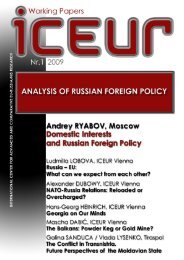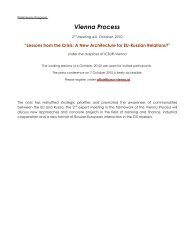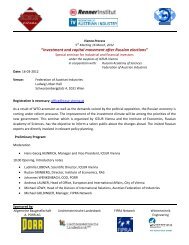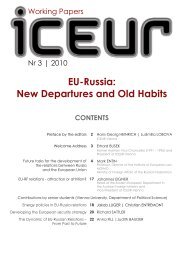Address - International Center for Advanced and Comparative EU ...
Address - International Center for Advanced and Comparative EU ...
Address - International Center for Advanced and Comparative EU ...
Create successful ePaper yourself
Turn your PDF publications into a flip-book with our unique Google optimized e-Paper software.
Alex<strong>and</strong>er DYNKIN<br />
Global Turmoil: Challenges <strong>for</strong> Russia<br />
Industry / sector Prior growth rate Possible cuts in supply<br />
Ferrous metals<br />
Nonferrous metals<br />
Gas<br />
Oil<br />
Automotive industry<br />
Retail, advertising,<br />
services<br />
3-5% per annum<br />
Historical price peaks<br />
in 2008<br />
3-7% per annum<br />
Historical price peaks<br />
in 2007-2008<br />
Historical price peaks<br />
in 2008<br />
Production peak in<br />
2007. Price hike - in<br />
June 2008 (prices<br />
grew 3 times over 1,5<br />
years)<br />
20-30%<br />
Up to 20% with price<br />
plummeting<br />
Export prices to fall<br />
from the end of 2008<br />
Decrease of<br />
employment<br />
10-30%<br />
10-20%<br />
10-20%<br />
10-20% (cuts in profits<br />
of US$15 billion in<br />
August 2008 10%<br />
Sales of new <strong>for</strong>eign- Up to 5% with prices<br />
made cars by 40% per falling slightly<br />
month until<br />
September 2008<br />
10-20% per annum<br />
Construction, Price multiplied<br />
construction materials 300-400% over<br />
10 years<br />
Expected cuts in the supply of goods/services in 2009<br />
Up 20%<br />
(advertising - up<br />
to 30%)<br />
20-30% (prices set to<br />
fall 20-50%)<br />
Manufacturers - 5%<br />
Dealers <strong>and</strong> service<br />
stations - up to 20%<br />
10-30%<br />
10-30%<br />
Banking 30-40% per annum (30-50%) 30-40%<br />
Possible investment<br />
downturn<br />
Investment programs<br />
to be slashed by<br />
50-150%<br />
Investment programs<br />
to be slashed<br />
Exploration of shelves<br />
fields in Yakutia <strong>and</strong><br />
Irkutsk region to slow<br />
down<br />
Some projects in<br />
eastern Siberia,<br />
northen shelves, etc.<br />
to be frozen<br />
New investment<br />
initiatives to be<br />
ab<strong>and</strong>oned<br />
Investment programs<br />
to be slashed<br />
by 100-200%<br />
New projects to be<br />
ab<strong>and</strong>oned <strong>and</strong><br />
existing projects to be<br />
frozen<br />
Liquidity levels to be<br />
maintained with<br />
budget monies<br />
Schedule 3<br />
successful. According to World Bank data, after November 2008, when G-20 met in Washington D.C., 17<br />
countries out of 20 (Russia included) introduced protectionist measures. Pittsburgh appeared to produce<br />
more tangible results, despite disagreements about off-shore zones. Maybe the 5th meeting in Seoul will put<br />
this important grouping of leaders on track. In the IMEMO our economic outlook <strong>for</strong> 2020, published in<br />
2008, we have made prognoses of the average annual growth of the world economy in 2005-2020 at the level<br />
of 4.1 – 4.2%. However, including a reservation that in case of a wave of protectionism, the tempo will be 2.1<br />
– 2.2% lower. When I sent the book to the publishing house at the very end of 2007, it seemed to me that this<br />
reservation was too optimistic.<br />
Thus, the main reasons why the Russian economy has proved to be so vulnerable in the face of the crisis are<br />
the following:<br />
- weak financial system,<br />
- high share of <strong>for</strong>eign capital in the stock market (around 60%),<br />
- heavy debt of Russian banks <strong>and</strong> companies to <strong>for</strong>eign investors,<br />
- dependence of social <strong>and</strong> economic development on export oil prices; energy exports account <strong>for</strong> 40%<br />
of budget revenues, <strong>and</strong> 70-80% (with gas) of all export earnings,<br />
- extremely high reduction of the liquidity of Russian banks <strong>and</strong> companies on the eve of the crisis due to<br />
the Russian Central Bank's struggle with inflation by tightening the money supply,<br />
- excessive budgetary expenditures due to the huge inflow of <strong>for</strong>eign currency in 2003-2007 <strong>and</strong> the first<br />
half of 2008, as well as high social commitments made by the state,<br />
- overvaluation of the ruble. Since 2001 its real effective rate rose by 145%.<br />
The situation in Russia resembles that in countries with relatively developed financial markets (India,<br />
8 IC<strong>EU</strong>R-Vienna Working Papers 2|2009









